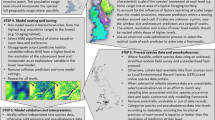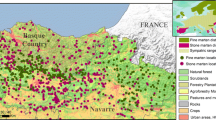Abstract
Habitat suitability maps are commonly created by modeling a species’ environmental niche from occurrences and environmental characteristics. Here, we introduce the hyper-envelope modeling interface (HEMI), providing a new method for creating habitat suitability models using Bezier surfaces to model a species niche in environmental space. HEMI allows modeled surfaces to be visualized and edited in environmental space based on expert knowledge and does not require absence points for model development. The modeled surfaces require relatively few parameters compared to similar modeling approaches and may produce models that better match ecological niche theory. As a case study, we modeled the invasive species tamarisk (Tamarix spp.) in the western USA. We compare results from HEMI with those from existing similar modeling approaches (including BioClim, BioMapper, and Maxent). We used synthetic surfaces to create visualizations of the various models in environmental space and used modified area under the curve (AUC) statistic and akaike information criterion (AIC) as measures of model performance. We show that HEMI produced slightly better AUC values, except for Maxent and better AIC values overall. HEMI created a model with only ten parameters while Maxent produced a model with over 100 and BioClim used only eight. Additionally, HEMI allowed visualization and editing of the model in environmental space to develop alternative potential habitat scenarios. The use of Bezier surfaces can provide simple models that match our expectations of biological niche models and, at least in some cases, out-perform more complex approaches.









Similar content being viewed by others
References
Anderson RP, Gonzalez I (2011) Species-specific tuning increases robustness to sampling bias in models of species distributions: an implementation with Maxent. Ecol Model 222(15):2796–2811. doi:10.1016/j.ecolmodel.2011.04.011
Blackburn WH, Knight RW, Schuster JL (1982) Saltcedar Influence on sedimentation in the Brazos River. J Soil Water Conserv 37(5):298–301
Brotherson JD, Dean F (1987) Tamarix: impacts of a successful weed. Rangelands 9:110–112
Busby JR (1986) A biogeoclimatic analysis of Nothofagus cunninghamii (hook) oerst in southeastern Australia. Aust J Ecol 11(1):1–7
Elith J, Graham CH (2009) Do they? How do they? WHY do they differ? On finding reasons for differing performances of species distribution models. Ecography 32(1):66–77. doi:10.1111/j.1600-0587.2008.05505.x
Elith J, Leathwick JR (2009) Species distribution models: ecological explanation and prediction across space and time. Annu Rev Ecol Evol Syst 40:677–697
Evangelista PH, Kumar S, Stohlgren TJ, Jarnevich CS, Crall AW, Norman JB, Barnett DT (2008) Modelling invasion for a habitat generalist and a specialist plant species. Divers Distrib 14(5):808–817
Franklin J (2009) Mapping species distributions: spatial inference and prediction. Cambridge University Press, Cambridge
Friedman JM, Auble GT, Shafroth PB, Scott ML, Merigliano MF, Preehling MD, Griffin EK (2005) Dominance of non-native riparian trees in western USA. Biol Invasions 7(4):747–751. doi:10.1007/s10530-004-5849-z
Fuller T, Morton DP, Sarkar S (2008) Incorporating uncertainty about species’ potential distributions under climate change into the selection of conservation areas with a case study from the Arctic Coastal Plain of Alaska. Biol Conserv 141(6):1547–1559. doi:10.1016/j.biocon.2008.03.021
Galvez A, Iglesias A, Cobo A, Puig-Pey J, Espinola J (2007) Bezier curve and surface fitting of 3D point clouds through genetic algorithms, functional networks and least-squares approximation. In: Gervasi O, Gavrilova ML (eds) Proceedings of computational science and its applications—ICCSA 2007, Pt 2, vol 4706. Lecture Notes in Computer Science. Springer, Berlin, pp 680–693
Graham CH, Hijmans RJ (2006) A comparison of methods for mapping species ranges and species richness. Glob Ecol Biogeogr 15(6):578–587. doi:10.1111/j.1466-822x.2006.00257.x
Guisan A, Broennimann O, Engler R, Vust M, Yoccoz NG, Lehmann A, Zimmermann NE (2006) Using niche-based models to improve the sampling of rare species. Conserv Biol 20(2):501–511. doi:10.1111/j.1523-1739.2006.00354.x
Hijmans RJ, Graham CH (2006) The ability of climate envelope models to predict the effect of climate change on species distributions. Glob Change Biol 12(12):2272–2281. doi:10.1111/j.1365-2486.2006.01256.x
Hinojosa-Diaz IA, Feria-Arroyo TP, Engel MS (2009) Potential distribution of orchid bees outside their native range: the cases of Eulaema polychroma (Mocsary) and Euglossa viridissima (Friese) in the USA (Hymenoptera: Apidae). Divers Distrib 15(3):421–428. doi:10.1111/j.1472-4642.2008.00549.x
Hirzel AH, Arlettaz R (2003) Modeling habitat suitability for complex species distributions by environmental-distance geometric mean. Environ Manage 32(5):614–623
Hirzel AH, Hausser J, Chessel D, Perrin N (2002) Ecological-niche factor analysis: how to compute habitat-suitability maps without absence data? Ecology 83(7):2027–2036
Hutchinson GE (1957) Population studies—animal ecology and demography—concluding remarks. Cold Spring Harbor Symp Quant Biol 22:415–427
Jarnevich CS, Evangelista P, Stohlgren TJ, Morisette J (2011) Improving national-scale invasion maps: tamarisk in the Western United States. Western North Am Naturalist 71(2):164–175
Kerns BK, Naylor BJ, Buonopane M, Parks CG, Rogers B (2009) Modeling tamarisk (Tamarix spp.) habitat and climate change effects in the northwestern United States. Invasive Plant Sci Manag 2(3):200–215
Lomolino MV, Riddle BR, Brown JH (2006) Biogeography, 3rd edn. Sinauer Associates, Sunderland
MacArthur RH, Wilson EO (1963) Equilibrium-theory of insular zoogeography. Evolution 17(4):373
Maraghni M, Gorai M, Neffati M (2010) Seed germination at different temperatures and water stress levels, and seedling emergence from different depths of Ziziphus lotus. S Afr J Bot 76(3):453–459. doi:10.1016/j.sajb.2010.02.092
Morisette JT, Jarnevich CS, Ullah A, Cai WJ, Pedelty JA, Gentle JE, Stohlgren TJ, Schnase JL (2006) A tamarisk habitat suitability map for the continental United States. Front Ecol Environ 4(1):11–17
Penman TD, Pike DA, Webb JK, Shine R (2010) Predicting the impact of climate change on Australia’s most endangered snake, Hoplocephalus bungaroides. Divers Distrib 16(1):109–118. doi:10.1111/j.1472-4642.2009.00619.x
Phillips SJ, Anderson RP, Schapire RE (2006) Maximum entropy modeling of species geographic distributions. Ecol Model 190(3–4):231–259. doi:10.1016/j.ecolmodel.2005.03.026
Pinay G, Fabre A, Vervier P, Gazelle F (1992) Control of C, N, P distribution in soils of riparian forests. Landscape Ecol 6:121–132
Soria-Auza RW, Kessler M, Bach K, Barajas-Barbosa PM, Lehnert M, Herzog SK, Bohner J (2010) Impact of the quality of climate models for modelling species occurrences in countries with poor climatic documentation: a case study from Bolivia. Ecol Model 221(8):1221–1229. doi:10.1016/j.ecolmodel.2010.01.004
Warren DL, Seifert SN (2011) Ecological niche modeling in Maxent: the importance of model complexity and the performance of model selection criteria. Ecol Appl 21(2):335–342. doi:10.1890/10-1171.1
Acknowledgments
This was a cooperative study between Colorado State University’s Natural Resource Ecology Laboratory and the USGS Fort Collins Science Center. Funding for this work was provided by a grant from the National Science Foundation (#OCI-0636210). Thomas Stohlgren’s contribution was partially supported by USDA CSREES/NRI 2008-35615-04666. Any use of trade, product, or firm names is for descriptive purposes only and does not imply endorsement by the U.S. Government. We also wish to thank Tom Hobbs for his instruction on the goals and methods for ecological modeling. HEMI was created within the BlueSpray application which is the property of SchoonerTurtles, Inc. To obtain a copy of BlueSpray, please contact Jim Graham at jimg@schoonerturtles.com.
Author information
Authors and Affiliations
Corresponding author
Rights and permissions
About this article
Cite this article
Graham, J., Young, N., Jarnevich, C.S. et al. The Hyper-Envelope Modeling Interface (HEMI): A Novel Approach Illustrated Through Predicting Tamarisk (Tamarix spp.) Habitat in the Western USA. Environmental Management 52, 929–938 (2013). https://doi.org/10.1007/s00267-013-0144-3
Received:
Accepted:
Published:
Issue Date:
DOI: https://doi.org/10.1007/s00267-013-0144-3




